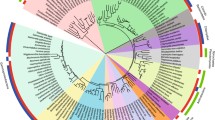Abstract
Helicobacter pylori infection increases the risk of cardiovascular diseases besides leading to duodenal and gastric peptic ulcerations. H. pylori cysteine-rich protein B (HcpB) is a disulfide-rich repeat protein that belongs to the family of Sel1-like repeat proteins. HcpB contains four pairs of anti-parallel alpha helices that fold into four repeats with disulfide bonds bridging the helices of each repeat. Recent in vitro oxidative refolding of HcpB identified that the formation and folding of the disulfide bond in the N-terminal repeat are the rate limiting step. Here we attempted to understand the disulfide formation of HcpB in the periplasm of Escherichia coli. The protein was expressed in wild type (possessed enzymes DsbA, B, C, and D) and knock out (Dsb enzymes deleted one at a time) E. coli strains. The soluble part of the periplasm when analyzed by SDS-PAGE and Western Blot showed that the wild type and DsbC/D knock out strains contained native oxidized HcpB while the protein was absent in the DsbA/B knock out strains. Hence the recombinant expression of HcpB in E. coli requires DsbA and DsbB for disulfide bond formation and it is independent of DsbC and DsbD. Prolonged cell growth resulted in the proteolytic degradation of the N-terminal repeat of HcpB. The delayed folding of the N-terminal repeat observed during in vitro oxidative refolding could be the reason for the enhanced susceptibility to proteolytic cleavage in the periplasm. In summary, a good correlation between in vivo and in vitro disulfide bond formation of HcpB is observed.



Similar content being viewed by others
References
Bader M, Muse W, Ballou DP et al (1999) Oxidative protein folding is driven by the electron transport system. Cell 98(2):217–227
Berkmen M, Boyd D, Beckwith J (2005) The nonconsecutive disulfide bond of Escherichia coli phytase (AppA) renders it dependent on the protein-disulfide isomerase, DsbC. J Biol Chem 280(12):11387–11394
Collet JF, Bardwell JC (2002) Oxidative protein folding in bacteria. Mol Microbiol 44(1):1–8
Deml L, Aigner M, Decker J et al (2005) Characterization of the Helicobacter pylori cysteine-rich protein A as a T-helper cell type 1 polarizing agent. Infect Immun 73(8):4732–4742
Depuydt M, Leonard SE, Vertommen D et al (2009) A periplasmic reducing system protects single cysteine residues from oxidation. Science 326(5956):1109–1111
Devi VS, Sprecher CB, Hunziker P et al (2006) Disulfide formation and stability of a cysteine-rich repeat protein from Helicobacter pylori. Biochemistry 45(6):1599–1607
Dumrese C, Slomianka L, Ziegler U et al (2009) The secreted Helicobacter cysteine-rich protein A causes adherence of human monocytes and differentiation into a macrophage-like phenotype. FEBS Lett 583(10):1637–1643
Godlewska R, Dzwonek A, Mikula M et al (2006) Helicobacter pylori protein oxidation influences the colonization process. Int J Med Microbiol 296(4–5):321–324
Graham DY, Yamaoka Y (1998) H. pylori and cag A: relationships with gastric cancer, duodenal ulcer, and reflux esophagitis and its complications. Helicobacter 3(3):145–151
Hennecke J, Sebbel P, Glockshuber R (1999) Random circular permutation of DsbA reveals segments that are essential for protein folding and stability. J Mol Biol 286(4):1197–1215
Kaakoush NO, Kovach Z, Mendz GL (2007) Potential role of thiol:disulfide oxidoreductases in the pathogenesis of Helicobacter pylori. FEMS Immunol Med Microbiol 50(2):177–183
Kolmar H, Waller PR, Sauer RT (1996) The DegP and DegQ periplasmic endoproteases of Escherichia coli: specificity for cleavage sites and substrate conformation. J Bacteriol 178(20):5925–5929
Luthy L, Grutter MG, Mittl PR (2002) The crystal structure of Helicobacter pylori cysteine-rich protein B reveals a novel fold for a penicillin-binding protein. J Biol Chem 277(12):10187–10193
McGee DJ, Mobley HL (1999) Mechanisms of Helicobacter pylori infection: bacterial factors. Curr Top Microbiol Immunol 241:155–180
Miki T, Okada N, Danbara H (2004) Two periplasmic disulfide oxidoreductases, DsbA and SrgA, target outer membrane protein SpiA, a component of the Salmonella pathogenicity island 2 type III secretion system. J Biol Chem 279(33):34631–34642
Mittl PR, Schneider-Brachert W (2007) Sel1-like repeat proteins in signal transduction. Cell Signal 19(1):20–31
Rietsch A, Belin D, Martin N et al (1996) An in vivo pathway for disulfide bond isomerization in Escherichia coli. Proc Natl Acad Sci USA 93(23):13048–13053
Tomb JF, White O, Kerlavage AR et al (1997) The complete genome sequence of the gastric pathogen Helicobacter pylori. Nature 388(6642):539–547
Author information
Authors and Affiliations
Corresponding author
Rights and permissions
About this article
Cite this article
Devi, V.S., Mittl, P.R.E. Monitoring the Disulfide Bond Formation of a Cysteine-Rich Repeat Protein from Helicobacter pylori in the Periplasm of Escherichia coli . Curr Microbiol 62, 903–907 (2011). https://doi.org/10.1007/s00284-010-9803-2
Received:
Accepted:
Published:
Issue Date:
DOI: https://doi.org/10.1007/s00284-010-9803-2




